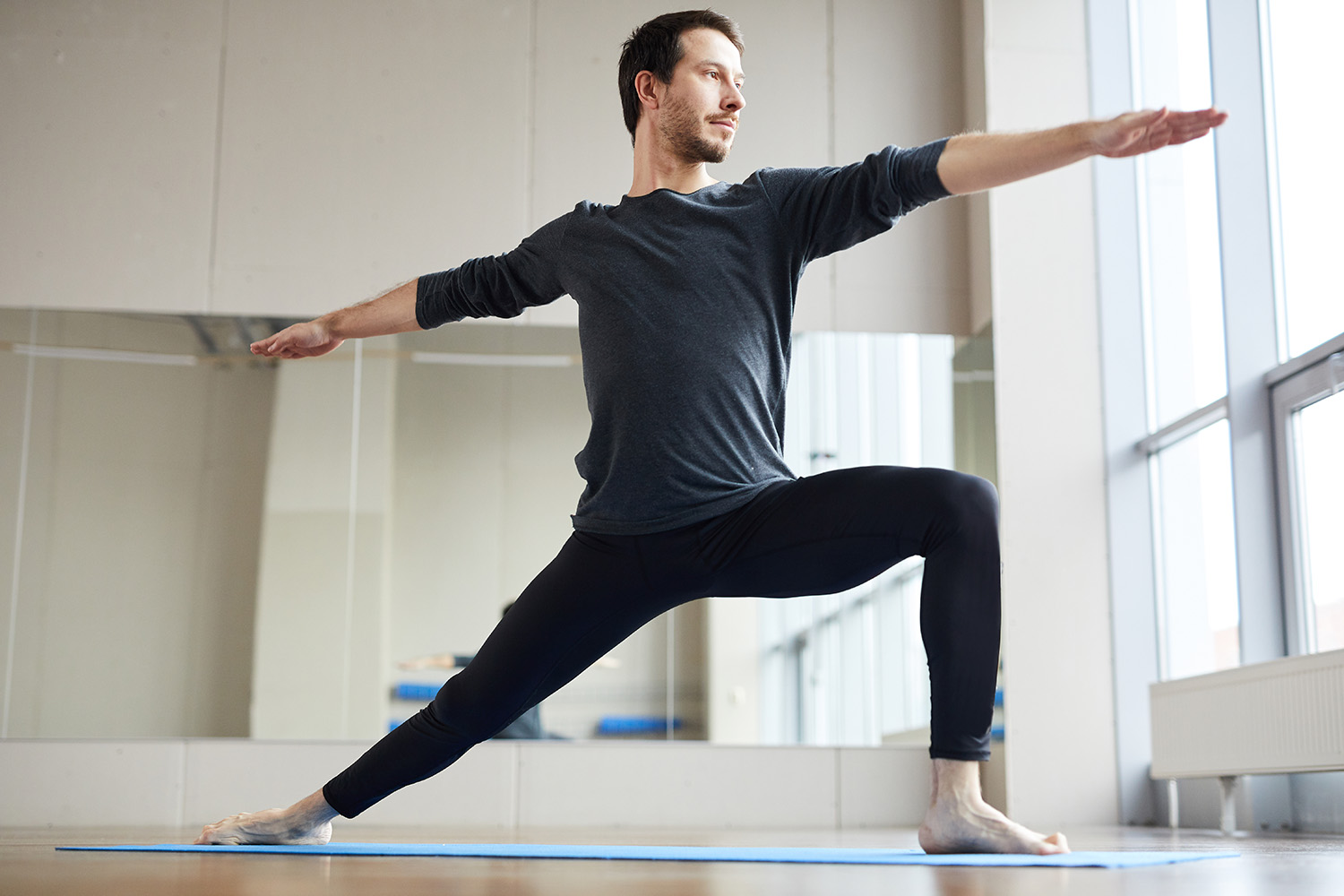Warrior II Pose, also known as Virabhadrasana II in Sanskrit, is a foundational yoga pose that embodies strength, focus, and grace. This dynamic posture, suitable for both beginners and advanced practitioners, has the power to energize and stabilize your practice.
Other Names for Warrior II Yoga Pose
Warrior II Pose is known by various names in different yoga traditions and languages. Some common alternate names for Warrior II Pose include:
- Virabhadrasana II (Sanskrit)
- Warrior II
- Virabhadrasana B (in the Ashtanga Yoga tradition)
How to do Warrior II Pose in Yoga
Proper alignment is crucial to fully experience the benefits of Warrior II Pose. Follow these steps for correct execution:
- Start in a standing position at the top of your mat, with your feet hip-width apart.
- Step your left foot back, turning it out at a 90-degree angle. Your right foot should be pointing forward.
- Bend your right knee, ensuring it’s directly above your right ankle, forming a 90-degree angle.
- Extend your arms out to the sides, parallel to the floor, with your palms facing down.
- Gaze over your right fingertips, keeping your neck and head aligned with your spine.
- Square your hips toward the long side of your mat and press down evenly through both feet.
- Engage your core and breathe deeply, holding the pose for 30 seconds to a minute.
- Repeat on the opposite side.
Variations of Warrior II Yoga Pose
Warrior II Pose offers several variations to cater to different levels of practice and preferences:
- Reverse Warrior (Viparita Virabhadrasana): In this variation, tilt your torso backward while keeping the front knee bent, reaching the left arm up and back, with the right hand resting lightly on the right leg.
- Extended Side Angle Pose (Utthita Parsvakonasana): Transition from Warrior II into this pose by lowering your right forearm to your right thigh and reaching your left arm over your head.
Modifications for Warrior II Yoga Pose
Warrior II Pose is accessible to most practitioners, but certain modifications can enhance comfort and accommodate specific needs:
- Widen Your Stance: If you have balance issues or feel unsteady, consider widening your stance for increased stability.
- Use Props: Place yoga blocks under your hands for support and balance.
Contraindications for Warrior II Pose in Yoga
While Warrior II Pose is generally safe, there are a few contraindications and precautions to consider:
- Knee or Hip Issues: Individuals with knee or hip injuries should approach the pose with care and may need to modify or avoid it.
Tips to improve Warrior II yoga pose in your practice
Tips to Improve Warrior II Pose in Your Practice
- Mindful Alignment: Focus on aligning your front knee directly over the ankle to avoid strain.
- Engage the Core: Keep your abdominal muscles engaged to support your lower back and maintain stability in the pose.
- Gaze Focus: Maintain a steady gaze over your front fingertips to enhance concentration and balance.
- Even Weight Distribution: Ensure equal distribution of weight between both feet to achieve equilibrium.
What Muscles Does Warrior II Pose Work?
Warrior II Pose engages and strengthens various muscle groups in the body:
- Legs: Strengthens the quadriceps, hamstrings, and calf muscles.
- Hips: Enhances flexibility and strength in the hip flexors.
- Core: Engages the abdominal muscles to stabilize the torso.
- Arms and Shoulders: Strengthens and tones the muscles of the arms and shoulders.
Mental and Emotional Benefits of Warrior II Pose in Yoga?
Beyond its physical aspects, Warrior II Pose offers numerous mental and emotional benefits:
- Confidence and Empowerment: Practicing Warrior II cultivates a sense of self-confidence and empowerment.
- Focus and Concentration: The pose requires a strong mental focus, enhancing concentration and presence.
- Steadfastness: It symbolizes unwavering determination and commitment, promoting emotional resilience.
Is Warrior II Yoga pose suitable for beginners?
Warrior II Pose is well-suited for beginners, serving as an accessible introduction to standing poses. Pay attention to alignment and steady progress.
Is Warrior II Yoga pose suitable for advanced practitioners?
Although foundational, Warrior II Pose remains valuable for advanced practitioners. It allows for refinement of alignment, deeper engagement, and exploration of variations.
How does Warrior II pose contribute to a yoga sequence or flow?
Warrior II Pose plays a significant role in yoga sequences and flows:
- Strength and Stability: It builds physical strength and stability, making it an ideal starting point in sequences that involve standing poses.
- Transitions: Warrior II acts as a transition pose, enabling practitioners to move seamlessly into other asanas.
- Alignment and Focus: The pose helps align the body, sharpen mental focus, and set an intention for the practice.
How can I deepen my practice in Warrior II pose?
To deepen your practice in Warrior II Pose, consider the following:
- Refine Alignment: Pay attention to the alignment of your hips, knees, and shoulders, striving for precision.
- Breathe Mindfully: Use your breath to enhance your connection to the pose, allowing it to guide your practice.
- Experiment with Variations: Explore variations like Reverse Warrior or Extended Side Angle Pose to challenge your practice and enhance the stretch.
What are some common mistakes in teaching Warrior II Yoga Pose?
To be an effective yoga teacher, it’s essential to avoid common teaching mistakes, including:
- Insufficient Alignment Instruction: Providing inadequate guidance on alignment can lead to improper form and discomfort.
- Neglecting Individual Variations: Failing to acknowledge that students have different body types and abilities can hinder their experience. Encourage modifications and offer options.
- Rushing Through Transitions: Encouraging rushed transitions into and out of the pose can lead to misalignment and disrupt the flow of the practice.
- Neglecting Hands-On Assistance: Not offering hands-on adjustments when necessary can deprive students of valuable feedback and guidance.
- Monotonous Teaching: Using the same cues repeatedly can lead to boredom and lack of engagement. Vary your instructions to keep the class engaged.
- Lack of Adaptability: Failing to adjust the pose based on students’ abilities and needs can result in a mismatch and disengagement.
In conclusion, Warrior II Pose (Virabhadrasana II) is a fundamental yoga pose that embodies strength, focus, and determination. It offers numerous physical, mental, and emotional benefits, making it suitable for practitioners of all levels. As a yoga teacher or practitioner, focusing on alignment, variations, and the mental aspects of this pose can deepen the experience and enhance its role in your yoga journey. Through mindfulness and proper guidance, Warrior II Pose can empower you to embrace your inner warrior spirit.
Namaste.

